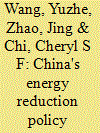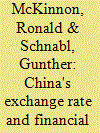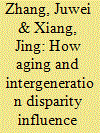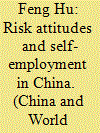| Srl | Item |
| 1 |
ID:
131400


|
|
|
|
|
| Publication |
2014.
|
| Summary/Abstract |
The paper examines the outcomes of and responses to the policy system (the "obligatory indicator system") used by the Chinese central government to induce provincial governments to meet energy-saving targets during the 11th Five Year Plan. The institutional mechanisms underlying the policy system that promotes implementation of energy saving are identified An analytical framework is developed to identify the strategic responses of provincial governments and the factors shaping their responses. Comprehensive sets of provincial data on economic and energy performance are collected and analyzed. The findings indicate that the central government's credible commitment to implement the policy system drove the initially disparate attitudes of provinces to a converged outcome. However, the outcome is significantly constrained by provinces' initial energy intensity. In particular, provincial governments have applied strategies of ceremonial implementation, efficiency-oriented efforts and effectiveness-focused efforts to attain specific targets. This paper discusses the implications in comparison with the modified obligatory indicator system in the 12th Five Year Plan and offers policy suggestions accordingly.
|
|
|
|
|
|
|
|
|
|
|
|
|
|
|
|
| 2 |
ID:
131397


|
|
|
|
|
| Publication |
2014.
|
| Summary/Abstract |
Instability in the world dollar standard, as most recently manifested in the US Federal Reserve's near-zero interest rate policy, has caused consternation in emerging markets with naturally higher interest rates. China has been provoked into speeding RMB "internationalization"; that is, opening up domestic financial markets to reduce its dependence on the US dollar for invoicing trade and making international payments. However, despite rapid percentage growth in offshore financial markets in RMB, the Chinese authorities are essentially trapped into maintaining exchange controls (reinforced by financial repression in domestic interest rates) to avoid an avalanche of foreign capital inflows that would threaten inflation and asset price bubbles by driving nominal interest rates on RMB assets down further. Because a floating (appreciating) exchange rate could attract even more hot money inflows, the People's Bank of China should focus on keeping the yuan/dollar rate stable so as to encourage naturally high wage increases to help balance China's international competitiveness. However, further internationalization of the RMB, as with the proposed Shanghai pilot free trade zone, is best deferred until world interest rates rise to more normal levels.
|
|
|
|
|
|
|
|
|
|
|
|
|
|
|
|
| 3 |
ID:
131398


|
|
|
|
|
| Publication |
2014.
|
| Summary/Abstract |
The paper considers the optimal transition path for China's exchange rate regime. How can China successfully make the shift from the current dollar peg regime to a more desirable regime, whether a basket peg or a floating regime? To answer this question, we develop a dynamic small open economy general equilibrium model. We construct four transition policies based on a basket peg or a floating regime and compare the welfare gains of these policies relative to maintaining the dollar peg regime. Two main results are derived from the quantitative analysis using Chinese data from 1999Q1 to 2010Q4. First, following a gradual adjustment to a basket peg regime is the most appropriate path for China to take, with minimal welfare losses associated with the shift in the exchange rate regime. Second, a sudden shift to the basket peg is the second best solution, and is superior to a sudden shift to floating because the monetary authority can efficiently determine optimal weights to attach to currencies in the basket to achieve policy goals once they adopt a basket peg regime.
|
|
|
|
|
|
|
|
|
|
|
|
|
|
|
|
| 4 |
ID:
131401


|
|
|
|
|
| Publication |
2014.
|
| Summary/Abstract |
Concurrent with market economic reforms, China is facing an increasing income gap and an aging population. The question addressed in the present paper is how much aging contributes to the rising disparity in consumption. Based on the model established by Ohtake and Saito (1998), our study shows that cohort effects contribute close to 60 percent of the rising consumption inequality, while approximately 10 percent is the result of aging. The growth of aggregate consumption inequality caused by the cohort effect has various implications. Strengthening the redistribution system, especially the tax system, may enable the economy to avoid further increases in income inequality.
|
|
|
|
|
|
|
|
|
|
|
|
|
|
|
|
| 5 |
ID:
131402


|
|
|
|
|
| Publication |
2014.
|
| Summary/Abstract |
Using the 2006 wave of the Chinese General Social Survey, the present paper examines the effect of risk attitudes on the likelihood of entrepreneurship in China. Our results show that risk attitudes have a nonlinear effect on the likelihood of being entrepreneurs. Risk neutral people are most likely to be entrepreneurs, while both risk averse and risk seeking people prefer to work for wages. When we further divide entrepreneurs into necessity and opportunity entrepreneurs, we find only a marginal difference in risk attitudes between wage workers and necessity entrepreneurs, while less risk averse individuals tend to be opportunity entrepreneurs. Our results have important policy implications for the government's efforts to promote entrepreneurial activities.
|
|
|
|
|
|
|
|
|
|
|
|
|
|
|
|